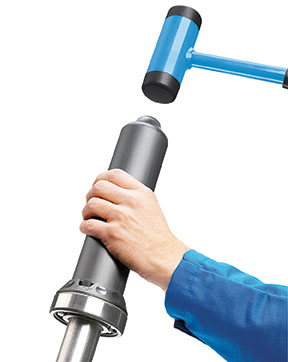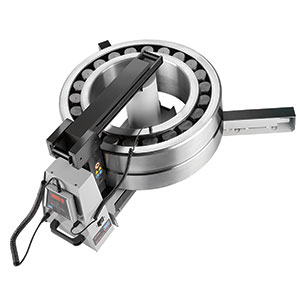From storage to dismounting, every aspect of a bearing’s service life can impact its performance and reliability.
11/20/2014
For any bearing used in rotating machinery, applying best maintenance practices and using the correct enabling tools can help contribute to maximum bearing service life. These practices include proper storage and mounting, adequate lubrication, and close monitoring and inspection that can uncover the root causes of any damage. While certain uses will present unique factors that influence a bearing’s service life, several general maintenance rules can preserve the working condition of bearings regardless of the application.
Tips for Storage
From the outset, proper bearing storage is critical. Bearings should always be stored in a cool, clean, low-humidity environment that is free of dust, shocks and vibrations—never directly on the floor. Ideally, bearings should be stored flat, rather than on end, in their original, unopened packages until mounting. If stored in a standing position, bearings are much more likely to experience false brinelling, the wear of raceways and rolling elements caused by residual vibration. Operators should be cautious when storing sealed or shielded bearings for long periods of time. The lubricating properties of the grease may deteriorate. For this reason, most bearing manufacturers have specific shelf-life limits that are based on the greases used in their bearings. Bearing cleanliness is also critical, because contamination and corrosion shorten the life of any bearing. Regardless of type or size, proper practices, from storage to dismounting, can impact a bearing’s performance, service life and reliability. (Images courtesy of SKF USA Inc.)
Regardless of type or size, proper practices, from storage to dismounting, can impact a bearing’s performance, service life and reliability. (Images courtesy of SKF USA Inc.)Proper Mounting Techniques
When a bearing is ready to be mounted, maintenance personnel should confirm that both the shaft and housing are clean, undamaged and dimensionally accurate (with proper fit and tolerance). They also must confirm that the lubricant is clean and correctly specified, that the necessary tools and equipment are available, and that safety precautions are followed. Because they are precision components, bearings should be handled and mounted with care, and operators should always use correct techniques and technologies. An estimated 16 percent of all premature bearing failures are caused by poor fitting, usually using brute force, and lack of awareness of suitable mounting tools and methods. When mounting a bearing, personnel should never strike it directly with any hard object, such as a steel hammer or chisel, or apply the mounting force through the rolling elements. The primary methods for proper bearing mounting are commonly referred to as “cold” or “hot,” consistent with their enabling technologies. Hydraulic techniques should be considered when mounting the largest bearings. Tools are available to accommodate each method. Cold mounting, or mechanical mounting, generally is recommended for small- and medium-sized bearings (with outside diameters of up to 4 inches). In cold mounting, the misguided practice of using a standard hammer and pipe has long been discredited because of the damage that can occur. This practice can cause debris to enter the bearing or a pipe to slip and impact the bearing’s internals. For a more reliable installation, the best practice is to use fitting tools to apply the proper force to both bearing rings, which isolates the rolling elements from impact force. Hot mounting, which involves preheating the bearing, is a practical solution for relatively large bearings that causes a bearing to expand, allowing for easier installation and the preservation of specified interference fit after the job is completed. Induction heaters can integrate various features to help prevent bearing damage during the heating process. These solutions are a safe alternative to less-effective and potentially dangerous methods such as open flames, hot oil baths, and ovens or hot plates. A fitting tool allows for the quick and easy mounting of bearings to minimize the risk of damage. This consists of a sleeve, impact ring and dead-blow hammer to effectively transmit the mounting force.
A fitting tool allows for the quick and easy mounting of bearings to minimize the risk of damage. This consists of a sleeve, impact ring and dead-blow hammer to effectively transmit the mounting force.Selecting the Right Lubricant
Choosing the proper lubricant helps bearings perform as long as intended. Good lubricants primarily provide a separating film between a bearing’s rolling elements, raceways and cages. This lubrication prevents metal-to-metal contact and friction that generate excessive heat, lead to adhesive wear, and cause subsequent metal fatigue and spalling of the bearing contact surfaces. The proper lubrication inhibits wear, corrosion and contamination damage. Half of all bearing failures attributed to poor lubrication are caused by the selection of an inadequate grease for the operating conditions or by mixing incompatible greases. The proper grease delivers the necessary base oil viscosity in the proper amount at the prevailing operating temperature. For this reason, the correct type of grease is essential for optimized bearing performance. Grease has traditionally served as the preferred lubricant for rolling bearings because of its practical benefits. Grease is easy to apply, can be retained within a bearing’s housing and offers protective sealing capabilities. Greases are classified by their stiffness or consistency according to the U.S. National Lubricating Grease Institute (NLGI) and are graded from NLGI Class 000 (very soft) to 6 (very stiff). These classifications are based on the degree of penetration that is achieved when a standard cone is allowed to sink into the grease at a temperature of 25 C for a period of five seconds. Grease composition varies from grease to grease but is roughly 85 percent base oil (mineral or synthetic) and 15 percent soap or thickener. The base oil is the oil inside the grease, which provides the lubrication under the operating conditions. The soaps or thickeners hold the oil and additives together to allow the lubricating grease to function. In some cases, they may enhance the lubricant film. The thickener gives the grease its characteristics, retaining the oil in the same way a sponge retains water. Additives provide additional benefits such as wear and corrosion protection and friction-reducing effects. By varying oil viscosities, soap and additives, users can benefit from greases with distinct characteristics that are able to suit particular applications and operating conditions. In service, sufficient lubrication is essential, so maintenance personnel should always strive to deliver the right lubricant in the right amount at the right time. Among lubricant delivery methods, manual lubrication with a grease gun can present major challenges for maintenance technicians if the appropriate tools, practices and knowledge are absent. Reliability can further be affected by under- or over-greasing. Large induction heaters for preheating the bearings before mounting allow for bearing expansion and easier installation.
Large induction heaters for preheating the bearings before mounting allow for bearing expansion and easier installation.
